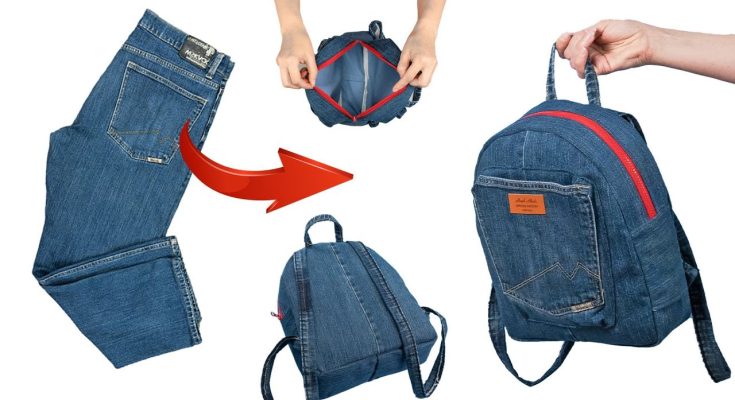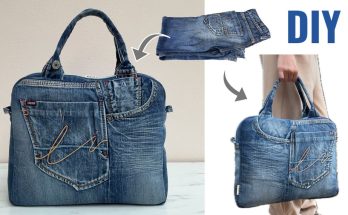You’re in for a fun and rewarding project turning old jeans into a cute mini backpack! This is a fantastic way to upcycle, create something unique, and add a handmade touch to your accessories. Denim’s durability makes it perfect for a backpack, and you can creatively incorporate original jean features like pockets for extra charm.
This detailed guide will walk you through making a lined, structured mini backpack with a flap closure, magnetic snap, and adjustable straps, all from an old pair of jeans.
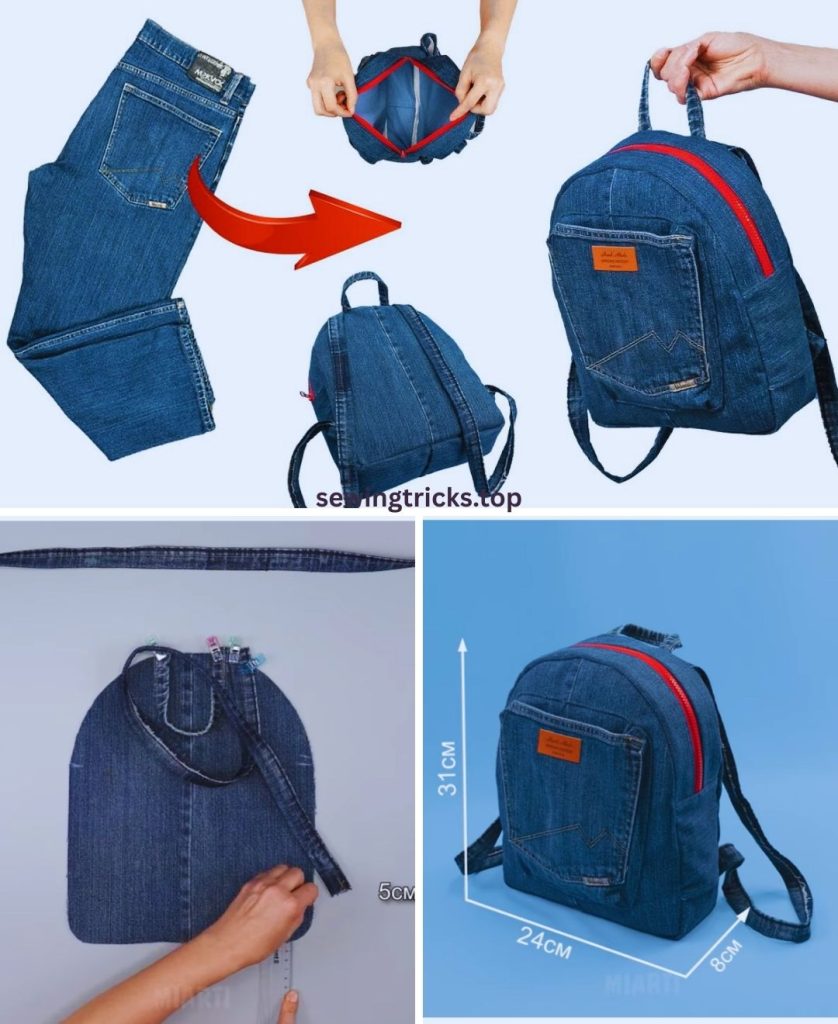
How to Sew a Cute Mini Backpack from Old Jeans (Easily!)
I. Planning Your Mini Backpack
Careful planning is crucial, especially when working with repurposed materials. It ensures you get the most out of your jeans and helps the project go smoothly.
- Choose Your Jeans Wisely:
- Size: A larger pair of adult jeans (men’s large or women’s larger sizes) will give you more usable fabric, making it easier to cut larger panels without excessive piecing.
- Fabric Type: Non-stretch or low-stretch denim is ideal. High-stretch denim can be tricky to sew and might result in a less structured backpack.
- Condition: Make sure the jeans are clean, free of major stains (unless you want that distressed look!), and ironed. Fading, rips, or patches can add unique character.
- Desired Backpack Size: A mini backpack is typically small, perfect for essentials like a phone, wallet, keys, and a few small items.
- A good target size: 9 inches wide x 10 inches tall x 3 inches deep (23 cm x 25.5 cm x 7.5 cm).
- Key Denim Features to Reuse:
- Back Pockets: These are perfect for the front of your backpack! They add instant utility and that classic jean look.
- Waistband/Belt Loops: Can be used for a top handle or decorative accents.
- Original Seams: The thick, topstitched seams can be incorporated into your design for visual interest.
- Lining: Highly recommended! A lining hides raw seams, provides extra durability, and gives your backpack a professional finish. You’ll likely need to supply new fabric for this.
- Closure: A magnetic snap under the flap is easy to install and secure.
- Straps: Adjustable straps are best for comfort. You’ll need some hardware for this.
- Stabilizer: Essential for a structured backpack! Without it, your denim backpack might be too floppy.
II. Gather Your Materials
Having everything ready before you start sewing will make the process much smoother and more enjoyable.
- Old Jeans: 1 pair of clean, ironed, sturdy denim jeans.
- Lining Fabric: 1 yard (0.9 meters) of medium-weight quilting cotton, broadcloth, or poly-cotton. Choose a fabric that complements your denim.
- Heavy-Duty Fusible Interfacing (ESSENTIAL!): 1 yard (0.9 meters) of heavyweight fusible interfacing (like Pellon 809 Decor Bond or Pellon 71F Peltex II Ultra Firm). This is critical for giving your backpack its structure.
- Hardware for Straps:
- 2 x 1-inch (2.5 cm) D-rings (or rectangular rings).
- 2 x 1-inch (2.5 cm) sliders (also called strap adjusters or tri-glide buckles).
- Magnetic Snap: 1 set, about 3/4 inch (1.9 cm) or 1/2 inch (1.27 cm) diameter.
- Matching Thread: Strong, all-purpose polyester thread. For topstitching on denim, use a slightly thicker topstitching thread in a contrasting color (like gold, orange, or beige) for that authentic jean look.
- Basic Sewing Supplies:
- Sewing Machine: Must handle thick layers. A walking foot is highly recommended as it helps feed thick fabric layers evenly.
- Heavy-Duty Needles: Denim needles (size 90/14 or 100/16) are essential for piercing thick denim. Keep spares on hand.
- Sharp Fabric Scissors or Rotary Cutter and Mat.
- Long Quilting Ruler or Measuring Tape.
- Fabric Chalk or Mark-B-Gone Pen.
- Plenty of Wonder Clips (superior to pins for holding thick denim layers).
- Iron and Ironing Board (crucial for pressing seams flat and fusing interfacing).
- Seam Ripper (your best friend for deconstructing jeans!).
III. Prepare Your Jeans & Cut Fabric Pieces
This stage is often the most time-consuming, but precision here pays off with a well-fitting backpack.
A. Deconstruct Your Jeans:
- Cut Off Legs: Lay the jeans flat and smooth. Using your sharp fabric scissors, cut straight across both pant legs, just below the crotch seam.
- Open Leg Seams: Use your seam ripper to carefully open up both the inseam (inner leg seam) and the outseam (outer leg seam) of each cut-off leg. This gives you two large, flat panels of denim fabric. Iron these pieces flat.
- Harvest Back Pockets (Optional): Carefully seam rip the back pockets off the jeans if you plan to reuse them.
- Cut Waistband for Handle (Optional): If you want to use a piece of the waistband for the top handle, cut off a section about 8-10 inches (20-25 cm) long, including a belt loop if desired.
B. Determine Your Panel Sizes (Example: 9″ W x 10″ H x 3″ D Mini Backpack):
We’ll use a consistent 1/2-inch (1.27 cm) seam allowance throughout.
- Main Body Panel Width: Finished Width + Finished Depth + (2 * Seam Allowance) = 9″ + 3″ + 1″ = 13 inches (33 cm)
- Main Body Panel Height: Finished Height + Finished Depth + (2 * Seam Allowance) = 10″ + 3″ + 1″ = 14 inches (35.5 cm)
- Flap Width: Finished Width + (2 * Seam Allowance) = 9″ + 1″ = 10 inches (25.5 cm)
- Flap Height: Varies, let’s say 5″ finished height + (2 * Seam Allowance) = 6 inches (15 cm)
C. Cut Your Fabric Pieces:
- Exterior Denim Pieces (from your jeans):
- Main Body (Front & Back): Cut 2 rectangles, each 13 inches wide x 14 inches high.
- Important on Piecing: You’ll likely need to piece together sections of your opened-up jean legs to get these large panels. (See “How to Piece Denim” from the previous answer, using a 1/2″ seam allowance and topstitching to join pieces).
- Side/Bottom Strip (Gusset): Cut 1 rectangle, 3 inches wide x 27 inches long (finished depth x (finished height x 2 + finished width)). This piece will form the sides and bottom of your backpack.
- Flap: Cut 1 rectangle, 10 inches wide x 6 inches high.
- Strap Connectors (for D-rings): Cut 2 rectangles, each 3 inches wide x 4 inches high.
- Top Handle (Optional, from waistband or denim scrap): 1 strip, about 2 inches wide x 8-10 inches long.
- Main Body (Front & Back): Cut 2 rectangles, each 13 inches wide x 14 inches high.
- Lining Fabric Pieces:
- Main Body (Front & Back): Cut 2 rectangles, each 13 inches wide x 14 inches high.
- Side/Bottom Strip (Gusset): Cut 1 rectangle, 3 inches wide x 27 inches long.
- Flap: Cut 1 rectangle, 10 inches wide x 6 inches high.
- Interior Slip Pocket (Optional): Cut 1 rectangle, 8 inches wide x 10 inches high.
- Heavy-Duty Fusible Interfacing:
- Main Body (Front & Back): Cut 2 rectangles, each 12 inches wide x 13 inches high (1 inch smaller on all sides than your main panels).
- Side/Bottom Strip (Gusset): Cut 1 rectangle, 2 inches wide x 26 inches long (1 inch smaller).
- Flap: Cut 1 rectangle, 9 inches wide x 5 inches high (1 inch smaller).
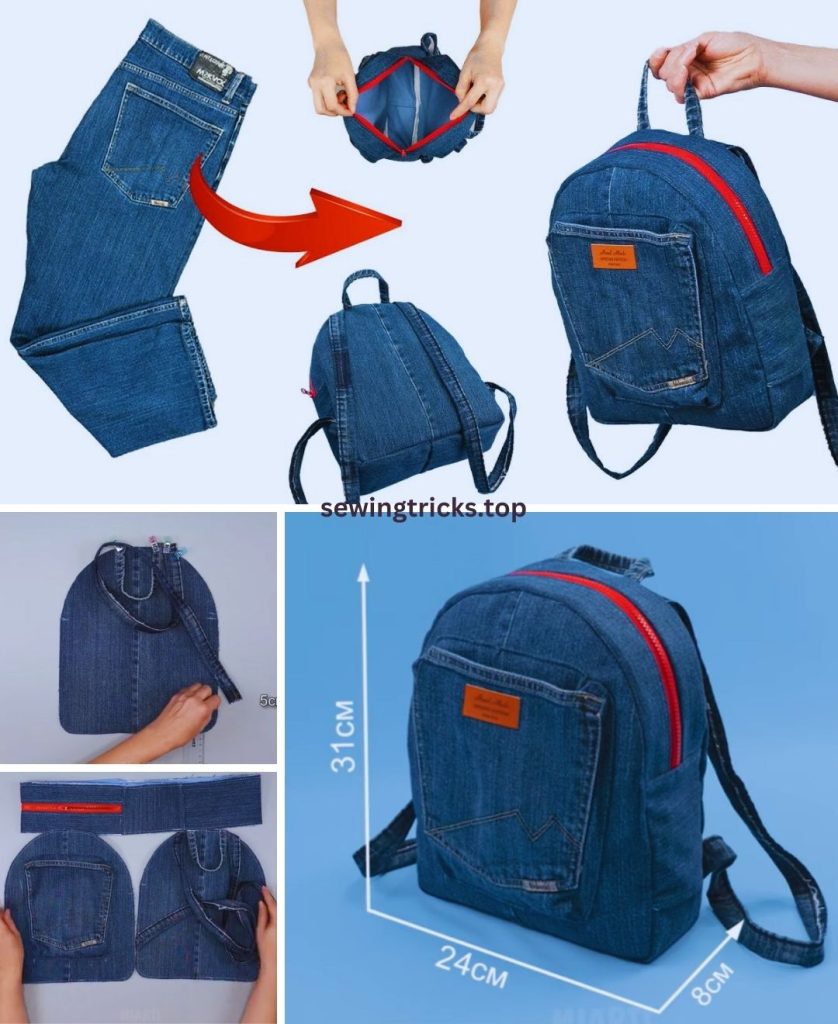
IV. Let’s Start Sewing Your Mini Backpack!
General Sewing Tips for Denim:
- Always use a fresh, sharp denim needle. Essential for preventing skipped stitches and broken needles.
- Use your walking foot. It’s a game-changer for feeding thick layers of denim evenly.
- Go Slow! Stitch slowly, especially over existing jean seams or pieced areas. Gently hand-crank your machine over very thick spots.
- Wonder Clips are superior to pins for thick denim.
- Press, Press, Press. Pressing seams open after each step reduces bulk and creates crisp results. Use a good, hot iron.
- Topstitching: Use a slightly longer stitch length (3.0-3.5mm) for all topstitching to get that authentic denim look.
Step 1: Prepare Exterior Denim Panels (Fuse Interfacing & Add Pockets)
- Fuse Interfacing: Lay each Exterior Denim Main Body Panel (front and back) and the Side/Bottom Gusset strip wrong side up on your ironing board. Center and fuse the corresponding Interfacing piece to each. Press firmly and allow to cool.
- Add Exterior Pockets (Optional): If using salvaged back pockets, position one on the Exterior Denim Front Body Panel. Topstitch the pocket in place along its two sides and bottom edge. Reinforce the top corners with an X-box stitch.
Step 2: Attach Strap Connectors
- Take your two Strap Connector pieces (3″ x 4″ denim).
- Thread one D-ring (or rectangular ring) onto each denim piece.
- Fold the denim piece in half, wrong sides together, aligning the 3-inch raw edges. The D-ring should be nestled in the fold.
- Stitch across the 3-inch raw edge, 1/2 inch (1.27 cm) from the edge. This creates a loop with the D-ring. Press the seam open.
- On the Exterior Denim Back Body Panel, find the center bottom edge. Measure up about 1.5 inches (3.8 cm) from the bottom.
- Pin one strap connector loop (with D-ring) to each side of the center bottom, with the raw edges aligned with the raw edge of the backpack panel, and the D-ring facing inward toward the center of the panel. The loops should be about 2-3 inches (5-7.6 cm) apart, centered on the panel.
- Stitch them in place within the 1/2-inch (1.27 cm) seam allowance, using a sturdy X-box stitch for reinforcement.
Step 3: Construct the Exterior Backpack Body
Use a 1/2-inch (1.27 cm) seam allowance.
- Take your Side/Bottom Gusset Strip.
- Take one Exterior Denim Main Body Panel (e.g., the front). Starting at the bottom edge of this panel, align the raw edges of the gusset strip and the main panel, right sides together.
- Clip all the way around the curve of the bottom corners and up the sides. Go slowly around the curves, easing the fabric to fit.
- Stitch all the way around, starting and stopping 1/2 inch from the top raw edge of the main panel. Backstitch at the beginning and end.
- Repeat this process to attach the second Exterior Denim Main Body Panel (the back, with D-rings) to the other side of the gusset strip. Again, start and stop 1/2 inch from the top.
- Press your seams open thoroughly to reduce bulk. Trim any excess fabric close to the stitching, especially on curves, being careful not to cut the stitches.
- Result: Your exterior backpack body is now formed, with an open top. Keep it wrong side out.
Step 4: Prepare and Attach the Flap
- Take the two Flap pieces (one denim, one lining). Place them right sides together.
- Stitch around three sides, leaving the top straight edge open. You can round the bottom corners slightly before stitching or just leave them square.
- Trim the seam allowance down to 1/4 inch (0.6 cm) on the stitched edges. If you rounded the corners, clip the curves.
- Turn the flap right side out. Use a point turner to gently push out the corners. Press the flap very thoroughly.
- Topstitch around the three stitched edges of the flap, about 1/8 inch (0.3 cm) from the edge. Use your topstitching thread.
- Attach Magnetic Snap: On the right side of the denim flap, mark the center point about 1.5-2 inches (3.8-5 cm) from the bottom curved/pointed edge. Attach one half of the magnetic snap here according to manufacturer’s instructions.
- Attach Flap to Exterior Backpack: On the Exterior Denim Back Body Panel, find the exact center of the top raw edge. Align the raw (unstitched) edge of the flap here, with the flap pointing down into the backpack. The snap should be facing the exterior.
- Stitch the flap in place within the 1/2-inch (1.27 cm) seam allowance. Stitch across it a few times for security.
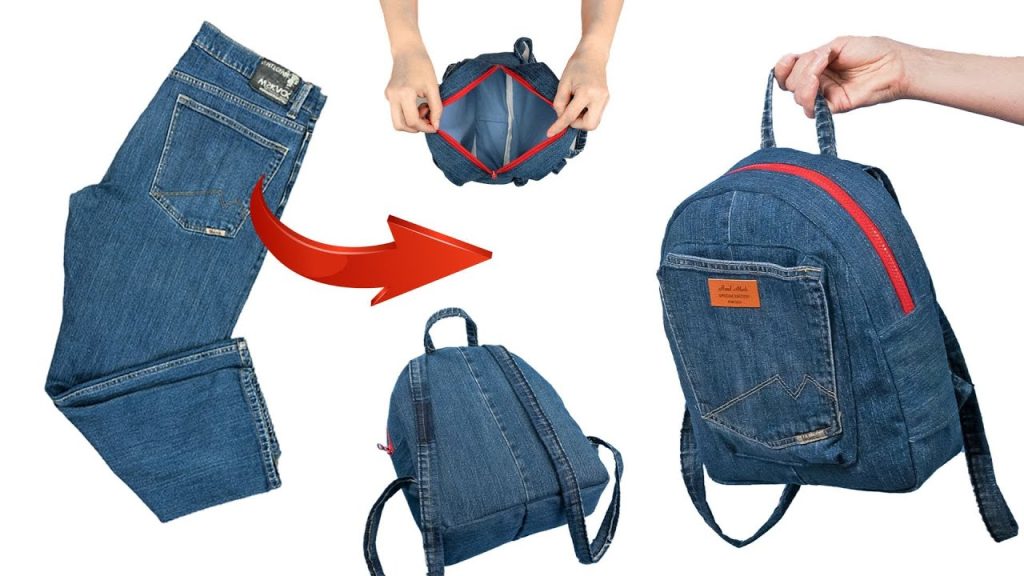
Step 5: Sew the Lining Bag Body (with Optional Pocket)
The lining is constructed almost identically to the exterior bag, but with a crucial opening for turning.
- Prepare Interior Slip Pocket (Optional):
- Take your 10″ x 12″ pocket piece. Fold it in half, right sides together, so it’s 10″ x 6″. Stitch around three sides, leaving a 3-4 inch (7.6-10.2 cm) opening on the remaining short side (bottom of pocket). Trim corners.
- Turn pocket right out through the opening. Press flat. Stitch the opening closed by machine (close to edge) or by hand (invisible ladder stitch).
- Attach Pocket: Take one Lining Fabric Main Body Panel. Position pocket about 4-5 inches (10-12.7 cm) down from the top, centered. Topstitch along its two sides and bottom edge. Reinforce top corners.
- Construct Lining Body:
- Attach the two Lining Fabric Main Body Panels to the Lining Gusset Strip using the same method as for the exterior bag (Step 3).
- CRUCIAL STEP: Leave an opening! When you are sewing the lining, somewhere along the straight bottom edge of the gusset, leave a 4-6 inch (10-15 cm) unstitched gap. This opening is absolutely essential for turning the entire backpack right side out later. Backstitch well at the start and end of the stitched sections around your opening.
- Result: Your lining backpack body is now formed, with an open top and a turning gap in the bottom. Keep it wrong side out.
Step 6: Create and Attach Adjustable Straps & Top Handle
A. Create Adjustable Straps (from new fabric or webbing):
- For 1-inch (2.5 cm) wide straps:
- You’ll need roughly two pieces of strap material, each 35-40 inches (90-100 cm) long.
- If making from fabric: Cut two strips 4 inches (10 cm) wide by 35-40 inches long. Fold in half lengthwise, press. Fold raw edges to center, press. Fold in half again. Topstitch along both long edges.
- Attach Hardware to Straps:
- Take one strap. Thread one end through a slider from the bottom up and over the middle bar. Fold the raw end over about 1 inch (2.5 cm) and stitch it down securely (stitch a box or X-box).
- Take the other end of the same strap. Thread it through a D-ring. Bring it back up and thread it under the middle bar of the slider. (This creates the adjustable loop).
- Repeat for the second strap, slider, and D-ring.
- Result: Two adjustable straps with a D-ring at one end and a sewn loop at the slider end.
B. Attach Straps to Exterior Backpack:
- On the Exterior Denim Back Body Panel, measure down about 1.5 inches (3.8 cm) from the top raw edge, and mark points roughly 2.5-3 inches (6.3-7.6 cm) in from each side seam.
- Take the raw end of one adjustable strap (the end that doesn’t have the D-ring). Align its raw end with the top raw edge of the backpack at one of your marks, with the strap pointing down into the backpack. Clip securely.
- Stitch in place using an X-box stitch within the 1/2-inch (1.27 cm) seam allowance. Repeat for the other strap.
- Result: Your straps are now attached at the top of the backpack and dangling down.
C. Attach Top Handle (Optional, if using waistband or denim strip):
- Take your prepared top handle piece.
- Find the exact center of the Exterior Denim Back Body Panel top raw edge (between your attached straps).
- Align the raw ends of the handle with the top raw edge, centering it. The handle loop should point down into the backpack.
- Stitch in place within the 1/2-inch (1.27 cm) seam allowance, backstitching for security.
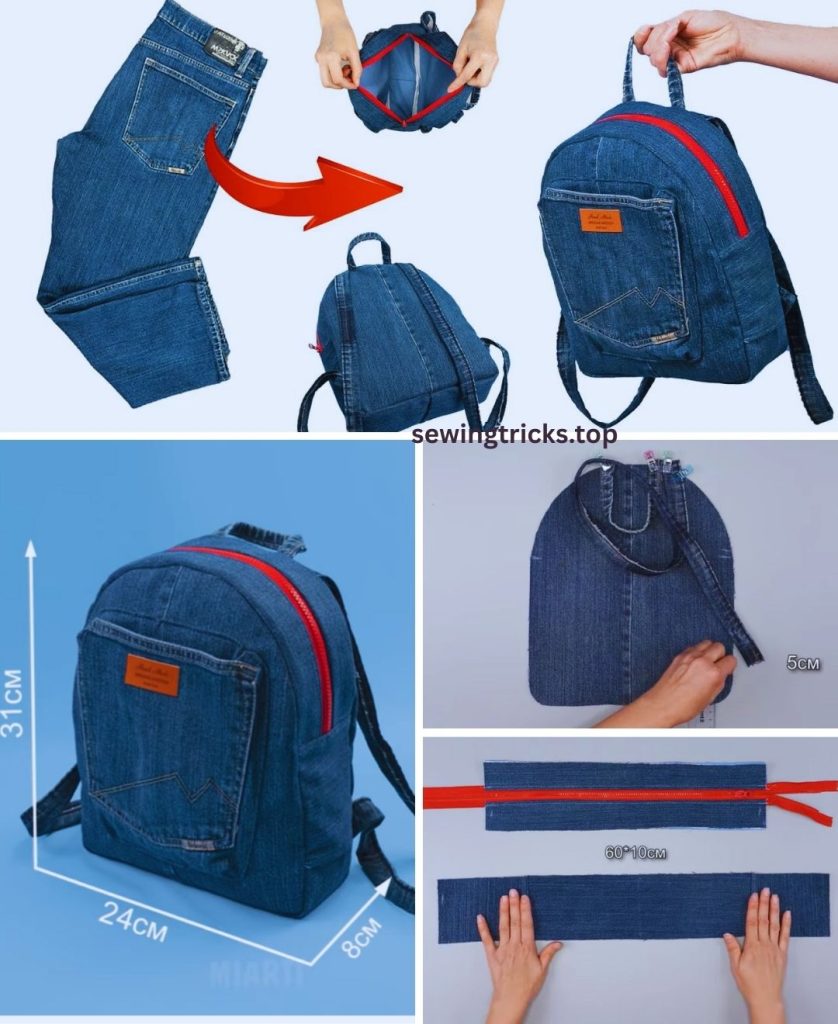
Step 7: Join the Exterior Bag and the Lining Bag (“Bag-in-a-Bag” Method)
This is the clever technique that encloses all raw edges at the top for a super clean finish.
- Ensure your exterior denim backpack is right side out, with the flap pointing down into the bag, and the straps pointing down into the bag.
- Ensure your lining bag is wrong side out (and still has that crucial turning opening at the bottom).
- Carefully insert the exterior denim backpackinto the lining bag.
- The right sides of both bags should now be facing each other.
- Align the side seams of the exterior bag with the side seams of the lining bag.
- Align the top raw edges of the exterior fabric and the lining fabric all around the entire opening of the backpack. The flap, handles, and straps should all be sandwiched between the layers, pointing down.
- Clip very securely all the way around this top edge, matching up seams precisely.
- Using your 1/2-inch (1.27 cm) seam allowance, stitch all the way around the entire top opening of the backpack. Go slowly and carefully, especially when you go over the thick handle attachment points and the flap. Backstitch at the beginning and end of your seam.
- Trim Bulk: Carefully trim the seam allowance at the top down to about 1/4 inch (0.6 cm) to reduce bulk inside the top edge.
Step 8: Turn Your Backpack Right Side Out & Finish
This is the incredibly satisfying moment your upcycled denim mini backpack takes its final, cute shape!
- Reach through the opening you left in the bottom seam of the lining.
- Slowly and carefully pull the entire backpack (exterior, lining, flap, straps, hardware – everything!) through this opening until it is completely right side out. Take your time, gently pushing out all the corners for a crisp, well-defined shape.
- Close the Lining Opening: Go to your ironing board. Press the raw edges of the opening in the bottom of the lining under by 1/2 inch (1.27 cm) so they meet neatly. Align these pressed edges and clip them together. Stitch this opening closed by machine (sewing very close to the folded edge for a neat finish) or by hand using an invisible ladder stitch for a truly seamless look.
- Now, push the lining down into the exterior denim backpack.
- Attach Remaining Magnetic Snap Half: Close the flap and determine the precise placement for the other half of the magnetic snap on the front of the backpack body. Mark and install it according to manufacturer’s instructions.
- Final Press & Topstitch: Carefully press the entire top edge of the backpack. Make sure the lining is fully tucked inside and isn’t peeking out over the top edge of the exterior fabric.
- For a super polished and durable finish, topstitch all around the entire top opening of the backpack, about 1/8 inch (0.3 cm) from the edge. Use your topstitching thread for this. This final topstitching marries the lining to the exterior, helps the bag hold its shape, and creates a crisp, professional look. You can also sew a second row of topstitching about 1/2 inch (1.27 cm) from the top edge for added detail and stability.
Your unique, upcycled denim mini backpack is now complete! You’ve transformed old jeans into a functional, durable, and super cute accessory that’s truly one-of-a-kind. Enjoy carrying your sustainable creation with pride!
What other fun upcycling projects are you planning to tackle?

